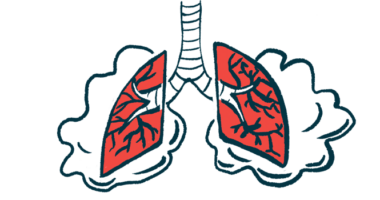Trikafta patients lower treatment burden, cut other therapies: Study
Patient use of other medications dropped significantly after starting Trikafta

After starting Trikafta, people with cystic fibrosis (CF) significantly reduced their use of other CF-related medications, suggesting that many people with CF on Trikafta “may prioritize reducing treatment burden over maximizing lung function,” researchers said.
Still, lung function continued to decline after Trikafta initiation, they reported in a real-world study.
“Further study is needed to determine the clinical consequences of reduced adherence,” the researchers wrote in the study, “Medication utilization and lung function changes after initiation of treatment with elexacaftor/tezacaftor/ivacaftor,” published in Pediatric Pulmonology.
CFTR modulators are a class of therapies that target the underlying cause of CF by improving the production and/or function of the CFTR protein. Trikafta is one such modulator containing three oral medicines — elexacaftor, tezacaftor, and ivacaftor — that correct defects in both CFTR’s production and function.
Before CFTR modulators, patients primarily relied upon supportive treatments, such as inhaled hypertonic saline (HS) or Pulmozyme (dornase alfa), which aim to clear the abnormal mucus build-up in the lungs that characterizes CF.
Reducing treatment burden
With the demonstrated benefits of CFTR modulators, there has been a growing interest in reducing the treatment burden among CF patients, despite CF Foundation guidelines recommending that patients remain on other CF therapies after starting Trikafta.
In support of a reduced treatment burden, the SIMPLIFY study (NCT04378153) showed that stopping inhaled supportive therapies did not negatively affect airway mucus clearance in CF patients with mild lung disease receiving Trikafta.
However, the extent to which patients treated with Trikafta take fewer therapies in real-world settings, and the clinical consequences of these decisions, are unknown.
To address this knowledge gap, researchers at the University of North Carolina investigated the use of medications among CF patients receiving Trikafta at their CF clinical centers.
An examination of pharmacy records, before and after Trikafta, identified 311 individuals prescribed any CFTR modulator between November 2016 and August 2021. Among them, 235 were prescribed Trikafta at least three times, and 117 of those were previously on CFTR modulator therapy.
Medication utilization was measured as the medication possession ratio, or MPR, defined as the actual number of months with filled prescriptions divided by the number of months with prescriptions. For all CFTR modulators, the average MPR was greater than 95%, meaning more than 95% of prescriptions were filled by CF patients each month.
Before Trikafta, the average MPRs were 37% for Pulmozyme, 46% for hypertonic saline, and 40% for pancreatic enzyme replacement therapy (PERT). These MPR values remained constant before Trikafta, but Pulmozyme and hypertonic saline use significantly declined after Trikafta’s introduction.
To account for prescriptions filled outside UNC’s pharmacy, researchers analyzed patients who regularly used the UNC mail‐order pharmacy. After Trikafta, the MPRs of all other medications, including PERT, significantly dropped in these patients, suggesting that many patients stopped using supportive therapies.
“A decrease in PERT utilization was not expected since the initial clinical trials have not suggested that [Trikafta] improves pancreatic function,” the researchers noted. “Reduced use of PERT could also reflect [Trikafta]‐related improvements in other aspects of [gastrointestinal] physiology, resulting in better absorption even with less enzyme replacement.”
Among 112 evaluable patients, lung function declined slowly over time, by an average of 0.8% per year in the pre-Trikafta era, as assessed by the percent predicted forced expiratory volume in one second (ppFEV1). Lung function continued to decline after Trikafta by 1.5% per year, but the difference between before and after Trikafta was statistically indistinguishable.
Overall, however, the average ppFEV1 increased significantly after Trikafta (82.6% vs. 74.5% before Trikafta).
Researchers suggested the ongoing ppFEV1 decline after Trikafta “is a short‐term phenomenon reflecting changes in routines and will stabilize with time.”
Adherence to inhaled medications did not explain lung function decline after Trikafta. There were no differences in the MPR of hypertonic saline or Pulmozyme among those whose lung function improved or worsened with Trikafta. Moreover, ppFEV1 decline did not correlate with MPR changes in hypertonic saline or Pulmozyme.
No other variables significantly correlated with post‐Trikafta lung function decline, including age, initial ppFEV1 values, and prior use of CFTR modulators.
“Initiation of [Trikafta] therapy is associated with reduced utilization of several CF medications, but changes in utilization did not have a clear impact on lung function within this study,” the researchers concluded.








